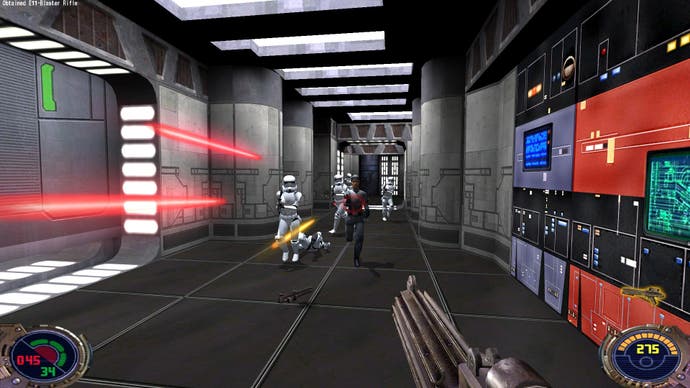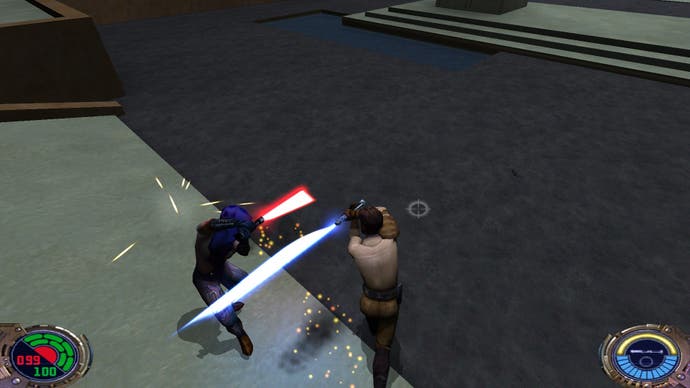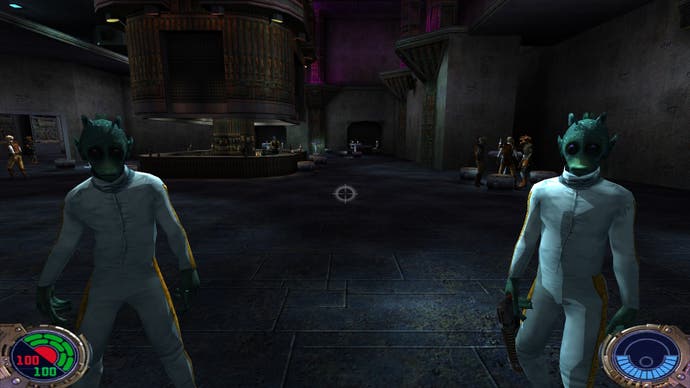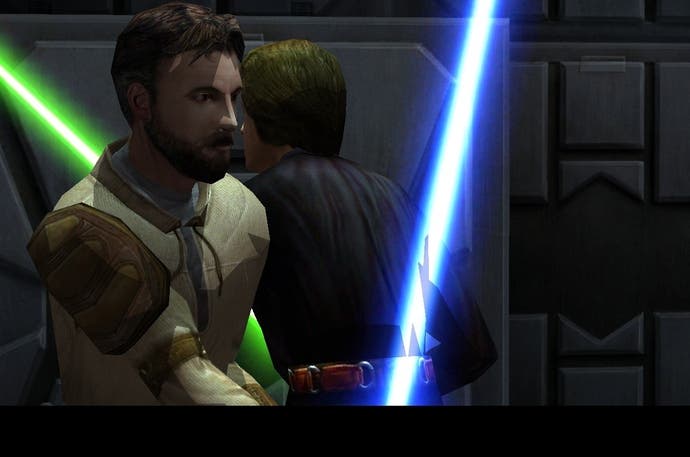Jedi Knight 2: Jedi Outcast retrospective
An elegant game for a more civilised age.
2002 was a bad time to be a Star Wars fan. Three years earlier The Phantom Menace had delivered a crippling body-blow to the franchise's credibility, and despite assurances of a more coherent story and less Jar-Jar Binks, the upcoming Attack of the Clones was winding up for the knockout. Meanwhile, the interceding years had seen a slew of prequel-based games that proved to be even more mediocre than the films. Put it this way, the best Star Wars game released at the time was Galactic Battlegrounds - which was essentially Age of Empires 2 wearing a Jedi robe.
Yet while George Lucas continued to devour his own child in cinemas worldwide, the games industry pulled itself together, and for a few years became the place to find quality Star Wars experiences, as it had in the mid-90s. BioWare began crafting what would become the best Star Wars adventure since Empire, and LucasArts announced a new Dark Forces game, which for me was even more exciting.
Dark Forces was my Doom. I was six years old when id's masterpiece came out, and an overprotective dad wouldn't let me near it. But he did let me play Dark Forces when it came out two years later, under the misguided assumption that a Star Wars game couldn't possibly be traumatic for children. The phase 1 Dark Trooper's metallic "NYYANG" noise haunted my dreams for weeks, but I was still enthralled by Kyle Katarn's first adventure, and Dark Forces 2 was even better, removing those hideous robot soldiers and adding that one green glowing ingredient missing from the original.

So after all that nonsense with Gungans and Midichlorians, the promise of Katarn's return in the new Millennium brought hope for better times, albeit with a little apprehension mixed in. LucasArts would not be at the helm. Instead development duties were handed to Raven software, who had recently done a good turn with the other major Star-based franchise in Star Trek Voyager: Elite Force. Unlike Elite Force, however, Jedi Knight wasn't only part of a venerated film and TV franchise; it was also a highly respected game series in its own right. No pressure, then.
The concern was needless. Jedi Knight 2 turned out to be Raven's finest hour, a game that stayed true to the series while simultaneously refining and improving it. Raven achieved this by focussing largely on the one area in which Dark Forces 2 had lacked - the lightsaber combat. Dark Forces 2 was a fantastic FPS with a lightsaber in it. Raven inverted this design, creating a fantastic melee combat game with some shooting in it. It was the first Star Wars game to get lightsabers right. And aside from its pseudo-sequel Jedi Academy, it remains the only Star Wars game to get lightsabers right.
Of course, you had to get hold of it first. Like Dark Forces 2, Jedi Outcast begins with Kyle saber-less and powerless, having shunned the Force after being tempted by the Dark Side in the previous game. It's a familiar ploy enabling the developers to reset the dial to zero, but it's slightly more sensible than the usual "I stubbed my toe and now I have amnesia." excuse. So Kyle and his trusty pilot Jan spend the first few levels shooting up Stormtroopers - part of the preposterously large Imperial "Remnant" whose officers still wear Imperial uniforms and insist on calling the New Republic "rebel scum".
At the time of release, there was substantial grumbling about these early, lightsaber-less levels. But I was glad Raven made me wait. Star Wars was always about more than space-wizards fighting with oversized glowsticks - something that seems to have been forgotten over the years. But not by Raven. Before discovering his affinity with the force, Kyle was more Solo than Skywalker, a callous and cynical mercenary who originally sided with the Empire before being convinced to defect by Jan. Kyle's experiences as a Jedi in Dark Forces 2 made him both wiser and beardier, but he's never above the odd pessimistic grumble or sarcastic quip. There's a great moment late in the game where Kyle sees the Shadow Trooper outfit for the first time. "Black armour. Not again." He mutters.

Playing those opening levels now, there's something curiously refreshing about them. The pace and fluidity lent to the game by its Quake 3 Team Arena engine feels so liberating after years of static cover-shooters. It's the gaming equivalent of stretching your legs after a long, long car journey. Sure, the Stormtroopers run around like heavily armoured schoolchildren, and the E-11 blaster rifle is so horribly inaccurate you'd have difficulty hitting the side of a Bantha with it, but those things just make the game more canonically Star Wars.
Admittedly, the gunplay begins to drag by the time you reach the third level, Artus Mine. But it isn't the lack of lightsaber which is the problem. It's that the game is far too stingy with the rest of its arsenal during the early stages. Jedi Outcast brings back some of the series' most memorable weapons, including the pellet-spitting Imperial Repeater, and adds a few of its own such as the Disruptor Rifle. Unfortunately these appear after Kyle collects his lightsaber, and so don't receive the attention they should. At the very least, Raven should have given the player a weapon to effectively dispatch Artus' awful bug-creatures that can apparently kill you by chomping on your ankles. Kyle himself quickly tires of them. "I thought I'd seen the last of these things," he groans at one point. It's a worrying sign when a developer starts making jokes about how annoying their own game is.
Even once you've finally retrieved your iconic laser-sword (which has mysteriously turned blue since the previous game. Maybe lightsabers can go stale) the game still doesn't quite hit its stride. The Nar Shaddaa levels are wonderfully designed, featuring that dizzying verticality Dark Forces games are famous for. But the towering cityscape is infested with nightmare-bastard Rodian snipers, capable of disintegrating you with a single, non-deflectable shot. Also, too much time is spent platforming around narrow ledges and walkways rather than slicing up Bounty hunter scum, and it doesn't help that Kyle moves as if he mistakenly polished the soles of his shoes, sliding across the ground ever-so-slightly after you've released the movement key. The number of times you'll slip off a ledge because of Kyle's greasy feet is almost enough to make you switch your PC off.

Almost, but not quite, because eventually you arrive at Bespin, and then the game transforms into something rather wonderful. Cloud City is where Kyle encounters the first of the Reborn, saber-wielding hoodies artificially infused with the Force. Raven astutely built the game's story around these adversaries. The powerful Sith-Lord and "overgrown monkey-lizard" Dessann manufactures his own private Jedi army by tricking Katarn into revealing the location of the Valley of the Jedi, and uses altered lightsaber crystals to infuse his followers with the Valley's powers.
Structurally it holds up fairly well, provided you can look beyond the embarrassingly poor cut-scenes, which were pretty awkward even at the time of release. They're probably the worst aspect of the game, a far cry from LucasArts' beautiful animations and FMVs. In addition, Dessann and his protégé Talion are portrayed with pantomime performances, though I'd happily take either over the prequels' Mannequin Skywalker. Besides, it is how the story is used to introduce new features to the game that is important; as it gave Raven the opportunity to provide regular and increasingly challenging lightsaber scuffles without the overall experience descending into absurdity.
And that's just as well, because it's the lightsaber, and fighting with it, that makes Jedi Outcast worthy of remembrance. Whereas most Star Wars treat the lightsaber as a neon truncheon you beat people with, in Jedi Outcast it is constantly active, deadly even when Kyle isn't swinging it. Press it against a wall and it will leave a glowing trail where cuts into the metal. Run up and poke a Stormtrooper in the eye with it and his helmet will begin to spark and smoke. And if you type in the most memorable cheat code of my adolescence. "Devmapall" followed by "g_saberrealisticcombat 1" you can enable Raven's grisly Ghoul 2 technology, that lets you chop up Stormtroopers like a summer salad.
But I'm older now, and slightly less sadistic (or at least better at concealing it). What truly elevates the melee combat are the acrobatics involved. It's odd that the cutscenes are so stiff and robotic given how much work went into animating the combat, but after embracing the Force, Kyle can leap tens of feet into the air, flip off walls, roll to evade enemy strikes, and spin and twirl in combat like a sharpened ballerina.
Unfortunately for Kyle, every Reborn soldier and Shadow Trooper is similarly empowered, and as a result lighstaber battles are these spectacular acrobatic dances where even the slightest touch of a blade can have deadly consequences. Combatants leap around the map like weaponised fleas, dodging each other's slashes, ducking under saber throws and trading force pushes and pulls. You might snare an enemy in a Force grip, only for them to blast you across the room with a lick of lightning. Or you might hurl your lightsaber at them, only for them to block it and send it clattering to the floor, leaving you completely vulnerable unless you can scoop it up again.

Every battle is completely unique. Some fights are hilariously brief, as a cocksure Reborn runs directly onto the point of your lightsaber, or mis-times a jump and plummets down a chasm. Others are epic struggles as your opponent matches you blow-for-blow, sabers crackling furiously as they clash over and over. Such fights are often interspersed with tense stand-offs in which the Reborn sheathes his saber and goads you into attacking. When one of you finally succumbs, you either punch the air at a well earned victory, or giddily reload to the point before the battle, wondering how it will play out this time. There's no better indication of a successfully designed game than when losing is fun.
While the single-player duels are great, with smartly designed arenas and sufficiently challenging AI, the best lightsaber duels undoubtedly lay in facing a human opponent. Raven clearly understood the strengths of their game, as they included a Duel mode in the multiplayer. Here two Jedi could face-off in single-combat, with rounds involving a "winner stays on" structure. It quickly became the mode of choice for dedicated players, with some clans adopting a Master/Padawan system to train newcomers in the finer arts of saber combat. At first I chuckled at this, and then it struck me how absolutely lovely it is. Expert players taking the time and effort to train the inexperienced. Modern multiplayer gaming could do with a dose of such altruism.
In fact, modern gaming could do with a dose of Jedi Outcast's design more generally. Playing it again highlights where later linear games went awry. It doesn't try to impress with overblown and restrictive set-pieces, flashy quick-time-events or locked combat animations. It never attempts to control how you play, how you fight or experience its environments. It doesn't need to. Those fluid, intricate, and liberating combat systems provide an endless supply of memorable moments, and because of that Outcast remains one of the best melee combat games in existence.

